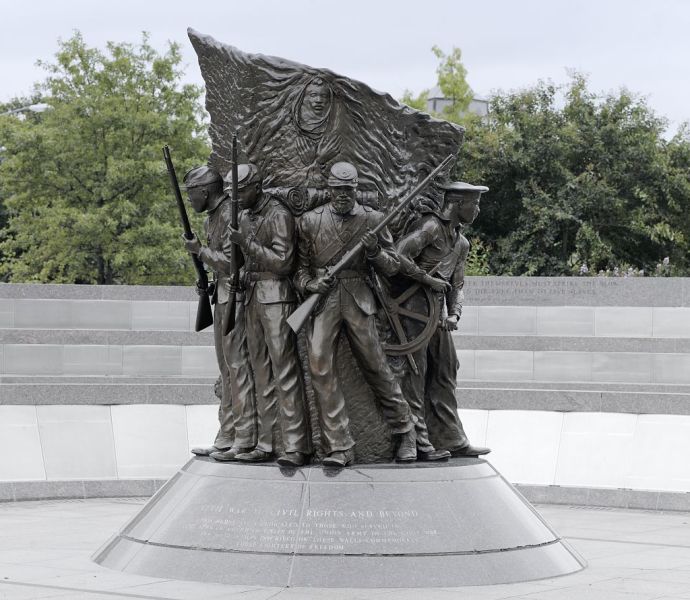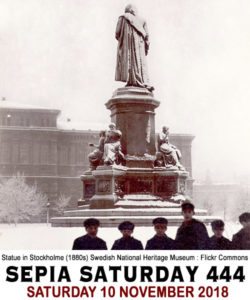- Abraham Cleage/Abram Cleag – I have so much new information, waiting to be written up.
- Charles A. Cleage – I have his pension file and that of his widow, waiting to be written up.
- George Cleage
- George Cleage There were two, I have not written up this one yet.
- Philip Cleage He died of smallpox, but his widow’s pension file is rich in information. Still have to write it up.
All of the men above belonged to the 1st Regiment, United States Colored Heavy Artillery
Organized at Knoxville, Tenn., February 20, 1864. Attached to 2nd Brigade, 4th Division, 23rd Corps, Dept. of Ohio, to February, 1865. 2nd Brigade, 4th Division, District of East Tennessee, Dept. of the Cumberland, to March, 1865. 1st Brigade, 4th Division, District of East Tennessee, to March, 1866.
SERVICE.-Duty at Knoxville, Tenn., till January, 1865. Operations against Wheeler in East Tennessee August 15-25, 1864. Operations in Northern Alabama and East Tennessee January 31-April 24, 1865. Stoneman’s operations from East Tennessee into Southwestern Virginia and Western North Carolina February to April. At Greenville and in District of East Tennessee till March, 1866. Mustered out March 31, 1866.
Meanwhile, in Kentucky, my grandmother Pearl Reed Cleage’s uncle Thomas Allen (formerly Thomas Ray, who later dropped his slave name of “Ray” and took his father’s name of “Allen”), served with the 5h Regiment USCT Calvary.
5th Regiment, United States Colored Cavalry
- Overview:
- Organized at Camp Nelson, Ky., October 24, 1864. Attached to 1st Division, District of Kentucky, Dept. of Ohio, to February, 1865. Military District of Kentucky and Dept. of Arkansas, to March, 1866.
- Service:
- Participated in Burbridge’s Raid from Kentucky into Southwestern Virginia September 20-October 17, 1864. Action at Saltsville, Va., October 2. At Lexington, Ky., October 19. Harrodsburg, Ky., October 21. Stoneman’s Raid into Southwestern Virginia December 10-29. Near Marion December 17-18. Capture of Saltsville and destruction of salt works December 20-21. Duty at Ghent, Paducah, LaGrange, Crab Orchard and Camp Nelson till August, 1865, and in the Dept. of Arkansas till March, 1866. Mustered out March 20, 1866.
Regiment lost during service 35 Enlisted men killed and mortally wounded and 1 Officer and 151 Enlisted men by disease. Total 187.
__________________
So much new information waiting to be written up, but to see what I have already done, click on the underlined links above.
-


An impressive statue! Many men on both sides of the Civil War lost their lives not only in battle, but illness took a great many lives as well. Good luck on catching up on all you’ve laid out for yourself to do in the future. Looks like quite a challenge.
It is a challenge because I am overwhelmed with the information from the files, which have affidavits which describe life during the Civil War and afterwards.
I’m so glad to hear of these ancestors of yours, and their involvement in the Civil War. It is not a pleasant subject, finding how people went about war, on both sides. Maybe some were considered heroes. But I am struck by all those that died of disease. What a waste. I’m glad that you have some goals with all your ancestors, and look forward to learning all about them. I’ve been chasing my ancestors for hours, but the ones back in England in the 13th century, who had “Sir” in front of many of their names, and were definitely fighting men as well.
None of these Cleages are related to me, but they came off of the same plantations as my Cleage ancestors – those of Samuel and his sons Alexander and David. The testimony given, by the formerly enslaved, and by members of the former slave masters family and neighbors, etc. have given me so much information that I did not have before. They clarified family relationships and even described the day that the Union Troops came through. Reading about the health issues and the poverty of the men who survived and their wives trying to get their pensions by documenting their illnesses, is very sobering.
Fine People All.
Folks who lived & organised together & were used to ‘watching the backs’ of each other, whatever,wherever, the threat might come .
I am minded that the Cleage’s were maybe, in some respects at least,similar to the British Pals Battalions during World War One ?
I don’t know if they had this plan in mind (the people in charge) or if it just happened that people from the same plantation and same area would all go into the service together and so would end up in the same battalion. Either way, I’m sure it was good to have at least some people you knew with you.
When I visit DC, I always enjoy looking at the statues. I’m going to have to look for this memorial.
I will look if I ever get to DC again.
One of the batteries of the Colored Heavy Artillery was placed very near my neighborhood. It took real courage for the freedmen to enlist in these units knowing the risk of fighting against their former masters. When I’m reading old military service records and regimental histories the thing I find remarkable is how most of the men walked/marched on foot carrying their own kit through the whole campaign.
What I found strange was that in their records, the USCT had the cost of their supplies taken out of the money they were to receive when they mustered out.
A very striking statue of a unit I knew nothing about. Good luck with your research.
Thank you Susan. I have so much research in the pension files at this point that the time consuming part is deciding how I want to write it up.
I look forward to reading your new information. You always come up with an interesting presentation, so I know you will get it sorted out eventually. It seems like I often find siblings and cousins in my family mustering in on the same day to the same unit.
It makes sense that they would travel together from their homes and join at the same time. Thank you, I can’t wait to get to it.
Off Topic Kristin
but
I just wanted to send you & yours my best wishes for 2019
Tony x